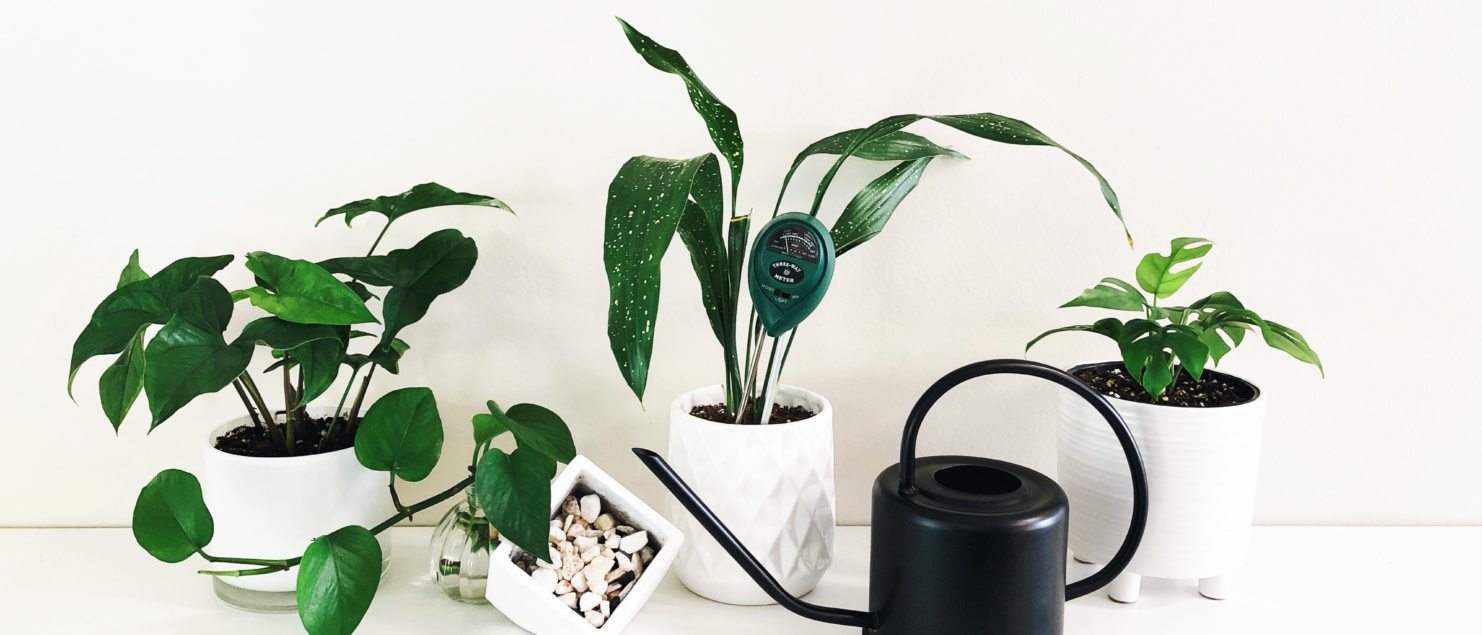8 Common Houseplant Care Mistakes
I’m totally not calling anyone out on this topic because…I’m just as guilty as you with some of these common houseplant care mistakes.
We all make mistakes, right? It’s what makes us human.
I though it was important to write this blog so you (and your plants) don’t have to go through the same trauma I did in the beginning, because most of these mistakes are some that I had done as a first-time plant parent.
Let’s just rip off the bandaid and start with one of the biggest common houseplant care mistakes of them all…
#1 No Drainage Holes
Hello, I’m a serial over-waterer and this was one of the biggest culprits of my overwatering.
When you plant a plant in a new planter that doesn’t have a drainage hole – unless you are a plant physic, it’s very hard to judge how much water the plant needs without drowning it.

If you use a planter without a drainage hole, you run the risk of it all pooling at the bottom, only for you plant to constantly sit in wet soil and eventually rot.
“And don’t even think about using rocks or pebbles at the bottom.”
That doesn’t really help with drainage either. This was advice I was given at the beginning from other plant blogs, and I won’t lie, it did work for a little while. I wound up rotting a few plants, even with rocks “for drainage”. This still causes the water to pool up and sit.
Think about water sitting in a cup for a long period of time, would you want to drink it? This can cause bacteria and algae to build up, that your plant will not enjoy.
The rocks can also be lodged into the root system. After a few years, I repotted my plant in the rocky bottom planter and it was such a hassle to remove all the rocks from the roots, that I lost almost 40% of the root system.
If you have a planter that doesn’t have a drainage hole, plant the plant in a nursery pot or a plastic pot that fits the planter.

*Helpful Tip: I often cut the nursery pot to make it fit into the planter. Example: cutting the top few inches so it doesn’t stick out, but enough you can pull it out of the planter, if needed.
#2 Using Tap Water
Going along with the topic of watering, using tap water isn’t super great for your plants.
I won’t say it’s the worst thing, but it can ultimately cause some problems depending on your water and the type of plant you’re watering.

For instance, if you have a home with hard water this can pose as a concern due to the amount of minerals that are in the water. Salts and certain minerals can cause a build-up in the soils, which your plants won’t like.
Chemicals like Chlorine is usually found in most tap water. Chlorine can cause burning on sensitive plants, causing scorched leaves.
“This is one of the reasons why my Calatheas got brown tips.”
If you have an option to filter your water (or buy filtered water) that would be best for your plants. This will remove any unnecessary substances in your plant’s drinks.
If you don’t have access to a filtration device, you can leave an open bottle/container of tap water out for 24 hours before watering. This causes the unwanted stuff to evaporate, essentially creating distilled water. Your plants will also appreciate the room temperature as well.
#3 Not Using The Correct Soil For Your Plants
It says houseplant potting mix, so…
Planting your plants in the correct soil for that particular plant takes a little bit of research.
The “standard houseplant soil” you find at Lowes or Home Depot is ok to use, but this should be a base to your soils.
Plants like Aroids like a chunky soil, so planting them into a regular houseplant soil mix will be way too heavy for them. Or if you plant a cactus in a soil that’s very dense with coco coir (which holds moisture) you won’t have a happy cacti.
Adding bark, charcoal, perlite, vermiculite, and sand – to name a few will take your soil from a standard soil to a customized soil for your plant.
Here’s a simplified cheat sheet that I created for you to help customize your soils, depending on your plants needs.

#4 Over & Under Watering
This seems like a no brainer but, watering your plants can be tricky.
Over watering can just be as bad as under watering. Some plants I have are ticking time bombs and I feel like are waiting for me to forget to water them, and BOOM dead.
“I’m looking at you Calatheas.”
When you over water your plants you run the risk of root rot, and when you under water you run the risk of the roots drying out so severely that it won’t or will be very hard to absorb water, as they used to.
Make sure your do your research and pick out a plant to your lifestyle. If you don’t have a bunch of time in the day, a high maintenance plant won’t be a good option.

To help avoid over/under watering, get yourself a moisture meter. This can help you gauge the soil moisture and let you know when it’s time to water.
#5 Not Using Fertilizer
I can hear your plants stomachs growling.
Plants need to eat too, and they eat in the form of fertilizer. When you fertilize your plants, you’re giving them the necessary nutrients they need to grow strong and healthy.

When I was first starting out in the plant world, I thought you only fertilized when your plants stopped growing or slowed down but, since my plants still were growing most of the year, I didn’t think I needed it.
But once I started to use it, my plants did a 360.
Fertilizing should only really happen in the spring/summer and slowing way down in the fall/winter, since your plants are in their growing stages in the spring/summer and slowdown in the fall/winter.
Check out my blog on how to properly fertilize your plants and what kind of fertilizers you can use.
#6 Not Enough Light
Consider your lighting when you’re buying a plant.
When I buy a plant, often times I know exactly where this plant will look the best, but it might not be best for the plant.

A plant that requires more light in a lower lit room with deal with some aesthetic problems. For instance, I had a succulent in my kitchen – which is in the middle of my house. This poor guy defiantly didn’t get the right amount of light and became frail and leggy. The pedals wound up falling off and I had to propagate him and start all over…but in a sunnier spot.
Make sure the spot you choose is right for your plant.
#7 Not Wiping Down Your Leaves
This may seem like an odd one, I only used to wipe down the leaves if they got dusty looking, basically not aesthetically pleasing and not for the benefit of the plant.

Plants help collect dust and partials in the air, but after a while it builds up on the leaves.
When a plant is covered in dust, it can’t absorb that light as well – which in return causes the plant to decline slowly and slow down growth.
I use a mixture of neem oil and water. I mix 6 parts water to 1 part neem oil. Dab it on a soft cloth and wipe those babies down! Make sure you get both sides of the leaf. The neem oil will make those leaves sparkle!
#8 Not Doing Your Research, Before You Buy
All that I have said above comes back to this one mistake.
REASEARCH YOUR PLANTS!

There are so many resources when it comes to plant care. Like: books, searching the internet, Botanical Brunette blogs, asking your grandmother (or grandfather), talking to an employee where you’re buying the plant, and so many more.
Making sure that you know all about a plant you’re buying will not only make the plant happy, but you as well.
Don’t Beat Yourself Up Over It
It’s ok to make a mistake every now and again. I’ve honestly learned so much from them.
And to make you feel a little better – these are common houseplant care mistakes. Common. Meaning we all have done these now and again.
I just wished I had a guide like this so I could maybe…make a few less mistakes.
Were these helpful? Which common houseplant care mistakes have you made?


